|
Download as PDF No doubt about it, for many new growers hops are a difficult crop to grow well. Fast growing hop plants require lots of balanced nutrients and water with critical timing of applications; making hops a real challenge to keep up with when compared to most other crops. Getting the hops to climb to the top trellis wire and produce fully developed side arms with lots of cones seems to be an unattainable goal sometimes. There always seems to be a guy named Murphy lurking around, ready to throw a wrench in the works; despite a hop grower’s best efforts. Wind, rain, drought, and pestilence... yet there are lots of pretty pictures of hopyards and recorded harvest yields to show it is more than a dream. It is common to find in many instances, less experienced hop growers do not fully understand many integrated hopyard management practices and how plant nutrient availability and growth is affected. This following discussion covers a few of the issues that have been identified as potentially holding back hop growth and yields. These issues are gleaned from talking to, and working with hundreds of new hop growers and the challenges they have experienced. These observations and field notes are intended to educate and provoke deeper, more in-depth discussions amongst hop growers and grower groups.
Soil Compaction (Back To Top)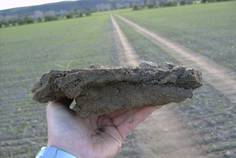 © Precision Agriculture © Precision Agriculture
Soil compaction in the hop row from season-to-season is probably the most common problem encountered when consulting a hop yard. Many growers prep their new hopyard sites by plowing and amending the soil prior to planting but fail to do this practice in following seasons. Why? To help preserve a permanent row cover crop? Don’t have the correct and necessary equipment? Hopyards DO require specialized equipment to operate and maintain - - it is time for new hop growers to get on board with this fact.
Hops are the second fastest growing plant in the world and have to develop a massive feeder root system each season to support the amazing bine growth rate. A critical part of this hop root system is the fine fibrous feeder root system that re-forms each spring in the top 6 inches of nutrient rich topsoil. Individual feeder roots may only last for 5 to 7 days before being replaced by new ones in a continual process. The fine hair-like feeder roots spread outward from the central crown and larger permanent roots as the spring season progresses. Their function is to find all the necessary macro and micro-nutrients and transport them up the plant using lots of available water. Poor feeder root development and management translates to poor hop bine growth. Roots only accumulate nutrients and water that come in direct contact with them. Anything that restricts a hop plant's root density results in less overall nutrient uptake. Most nutrient-collecting roots grow in the top 6 to 8 inches of soil because that’s where the microbes, nutrients, and oxygen are located. Nutrient uptake grinds to a halt if soil oxygen levels and exchange rates with the atmosphere are limited by soil compaction. It doesn’t matter if the soil test says all the soil nutrients are present and accounted for – the plant can’t take them up in sufficient quantities without the soil oxygen being present. The perfect rooting conditions are nutrient rich, well-aerated soils with adequate moisture present. This is sometimes referred to as a soil having good tilth. How can a compacted soil be corrected? First identify the ALL possible factors causing the compaction; then apply the best actions to correct it.
Improper Soil pH (Back To Top)
The majority of commercial hop varieties prefer a slightly acidic soil. A soil pH of 6.2 to 6.8 works well for most hop types (there’s always exceptions). Soil pH in a nutshell, is simply a method of measuring soil acidity or alkalinity levels by measuring the electrical charges present. All soil minerals and nutrients carry either positive (cations+) or negative (anions-). Many are metallic - Iron, Zinc, Copper, Boron, Magnesium, Manganese, and so forth. When a soil pH is in electrical balance all the different nutrients are available. When it is too high(+) or too low(-), many different nutrients and processes are blocked and nutrients become less available to the plant. (Root surfaces also have electrically charged sites that match up with the different charged nutrients- kind of like a matched lock and key system). Improper soil pH slows down microbial activity and organic matter decomposition rates. A wrong soil pH coupled with the soil compaction cascade effect described above is a real growth killer. This is a very common issue in hopyards experiencing poor overall growth.
Irrigation Issues (Back To Top)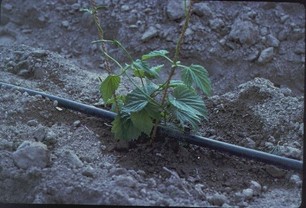
Irrigation is a lot more complex than most growers realize. Hops have both shallow and deep root systems and it is the shallow root system in the top 6 inches of topsoil that is responsible for most of the nutrient and water uptake during the short formative high growth phases of climbing the trellis and forming sidearms/cones. Most hopyards employ drip irrigation to deliver both water and supplemental plant nutrients. Choosing the right irrigation system design; how it is installed and operated are important issues. Here are a few of the common mistakes we have seen growers make.
Complete Soil Testing (Back To Top)
Many hop growers do not realize the value of accurate and timely testing of their soils in their hopyards. The goal of all soil testing is to inform the grower of what nutrients are available at the beginning of the growing season; middle of the season, and what is left at the end of the season. These test help identify nutritional problems before they cause problems and what needs to be replaced or amended. It is strongly advised for inexperienced new growers to do testing three times during the season. A complete soil test includes soil pH, alkalinity, organic matter, macro elements, microelements, cation exchange capacity (CEC), and cation saturation. A foliar test should also show the complete range of elements; not just N-P-K levels.
Fertilizer Issues (Back To Top)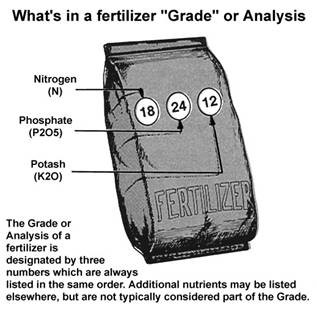
Selecting and applying the right combination of fertilizers is a definite grower skill. It requires knowing the soil profile/pH, the irrigation water quality, the individual hop varieties, understanding soil/foliar tests, and some pretty complex nutrient interactions. Successful hop growers find that applying a combined program of organic, granular, and drip line fed soluble fertilizers at appropriate times of the growing season is the most successful. Hops have high uptake requirements for many micronutrients besides the major N-P-K elements. If any of the minor elements are deficient, hop growth is compromised. Many growers use additional foliar-fed fertilizers with micronutrients at key stages of hop growth as insurance against having a micronutrient deficiency. Here are a few common fertilizer issues that have been encountered.
Annual Nutrient Replacement (Back To Top)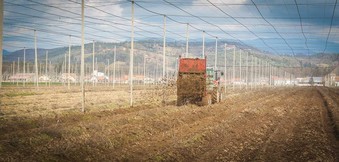
Hops are like a big nutrient-sucking vacuum cleaner. The shallow feeder root system is very dense and very efficient at scavenging all the nutrients from the surrounding topsoil. Each year the hop crown grows larger and requires more nutrients than the year before. Only by limiting the size of the crown and root structure in mature hopyards can overall nutrient needs be stabilized. In the wild, hops deplete soil in one area and physically move to new areas via long, spreading rhizomes. Replacing the depleted nutrients removed each season from the hopyard soil is a major challenge for hop growers. Growers should have a complete post-harvest soil test done to see what the real rates of nutrient depletion are. It is best practice to apply soil amendments in several smaller applications versus a single bulk application each season. This avoids the potential of blocking balanced uptake of other nutrients.
Ongoing annual replacement of nutrients should be considered a year-around continuous effort. The goal is threefold : 1.)To replace the depleted nutrients with balanced long term sources; rather than reactive quick fixes. 2.) To increase the nutrient holding capacity of the soil. (CEC) 3.) To rebuild soil organic matter and increase soil microbial activity to improve nutrient conversion and efficiency. Both are essential to the humic acid cycle and good soil tilth. Many soil and plant processes are interdependent on the balance of nutrients in the soil and plant. Too much of one nutrient will block uptake of another. Too little of another element will stop a complex conversion process. It is easy to mess this natural balance up. Here are a few things to avoid.
Rhizome Management (Back To Top)
Hops produce shallow underground budded runners called rhizomes. These are not roots. (Hop roots are white and do not have latent buds). Rhizomes naturally function to allow a hop plant to continually spread outward in the wild; searching for favorable locations to re-establish. In commercial cultivation of hops these unwanted rhizomes have to be removed annually or semi-annually to keep the hop plants from spreading into the aisles. If the rhizomes are not removed, they divert energy from the crown and the climbing bines, resulting in lower yields of hop cones. The hopyard tillage steps described above are recommended for timely early spring/ late fall rhizome removal.
Weed Management (Back To Top)
Tillage Techniques (Back To Top)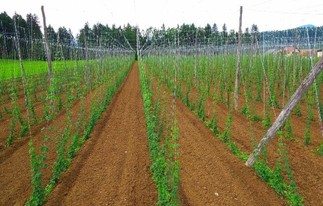
Hops annually form a dense shallow feeder root mat structure as the growing season progresses. It forms in the top 6 to 8 inches of soil. This feeder root system is responsible for absorbing all the water and nutrients required to push the hop up the twine once the permanent deep roots have exhausted their stored sugars and carbohydrates used for spring emergence. Tilling too close, too deep, or at the wrong time can severely stunt the growth of hops. Here are some tips.
Fungicide / Nutrient Interactions (Back To Top)
Many fungicides applied to hopyards contain metallic compounds, oxidizers, and acids that affect plant nutrition. Here are a couple of the common interactions encountered.
Out of Balance Nutrient Interactions (Back To Top)
Plant nutrients and soil particles carry specific electrical charges and nutrient availability for plant uptake is a complex interactive process, to say the least. There is a wealth of technical information on the subject of plant nutrition and it would take a Rhoades scholar to interpret it all. Here are a few of the interactions that have been identified. Use this information to help spot potential out of balance issues in soil and foliar tests.
Cover Crops in a Hopyard (Back To Top)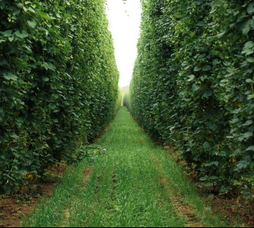
Cover crops are making a comeback in agriculture. Annual cover crops are used in agriculture and hopyards to:
Pests and Pathogens of Hops (Back To Top)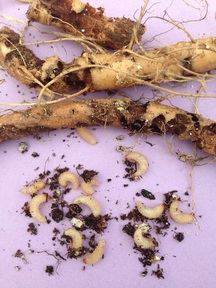 Photo courtesy Great Lakes Hops Labs Photo courtesy Great Lakes Hops Labs
There are complete books written on this subject and it is best to defer to them, rather than rewrite them here. However, here are a few things hop growers need to know that may not be clearly presented in books as it pertains to hops production:
Over Wintering Hops in a Commercial Hopyard (Back To Top)
In many regions dormant hop crowns left exposed during the winter months suffer crown and bud damage and loss to winter freeze-thaw cycles and desiccation. The fix is simple – cover them with a shallow layer of field soil a minimum of 1 to 2 inches deep. This will act as a buffer against freeze-thaw cycles and provides moisture to prevent bud desiccation. Hop growers that hill the hop rows during the season are automatically covered by this practice.
Hopyard Site Selection (Back To Top)
Hops in general, prefer slightly acidic, well-drained sandy loam soils pH 6.2 -6.8. The farther the site’s soil deviates from this, the harder hops will be to grow and suitable hop cultivar selection will be narrowed.
Mulches and Composts (Back To Top)
Mulches and composts are different from each other. Mulches are surface applied organic matter that may not be decomposed. Examples would be leaves, wood chips, shredded bark, alfalfa hay, straw, and etcetera. Composts are fully decomposed forms of mulches and manures with a stable carbon to nitrogen ratio. Properly prepared composts go thru a high temperature phase which kills harmful pathogens and weed seeds. Mulches do not and can be sources of pathogen if not selected carefully.
Cutting, Mowing, and Carping of Hop Crowns and Bines (Back To Top)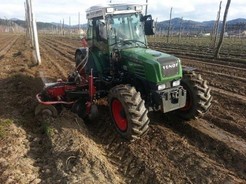
This is a topic with much discussion amongst new hop growers. There are several points to be made and the final benefits are still being debated. In regions like the Pacific Northwest where spring may begin in late February and bine training dates are not until mid-May, the hopyards may be mowed several times to keep bine growth under control. The debate is about if hop growers in other regions with shorter spring times would have any benefits from mowing hops once more before training; or if the recovery time left before cone initiation is too short.
|
Details
Blog AuthorLynn, the head hop grower at Great Lakes Hops has over 30 years of experience in the horticultural field. Browse the blog articles here to find useful growing information for humulus lupulus, based on personal experience and observations at Great Lakes Hops. Archives
January 2020
Categories
All
|
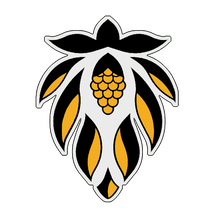

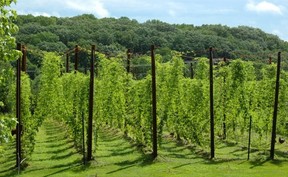
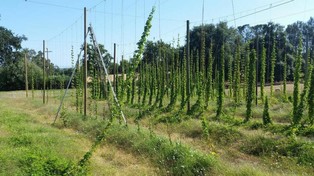

 RSS Feed
RSS Feed